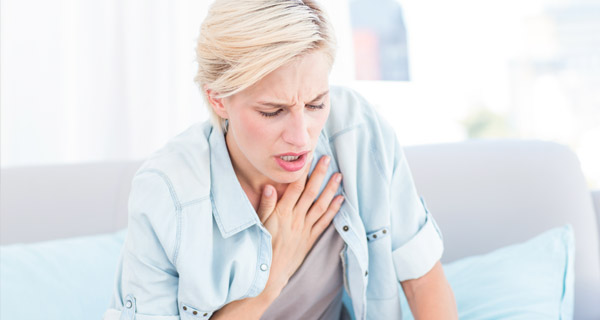Emergency plan – What to do for shortness of breath?
An asthmatic attack in adults and children is accompanied by symptoms such as shortness of breath, wheezing and coughing. The symptoms can be categorised according to their severity and further outward signs:

A mild to moderate asthmatic attack can be recognised from the following signs:
- The patient is able to speak normally
- Shortness of breath
- Difficulty in breathing
- Wheezing and hindered exhalation
- Coughing and increased mucus formation
A serious asthmatic attack can be recognised from the following signs:
- The patient is no longer able to speak normally
- Pulse and breathing rate are significantly elevated
- The patient appears to panic
- Lips attain a blue discolouration
- The peak flow value is below 50% of the desired value
Well prepared for emergencies
The following tips are intended for asthma patients, parents of asthmatic children, and first-aiders:
- Undergo asthmatic patient training. Here you will learn, among other things, what to do in case of emergency, and will become familiarised with breathing techniques and body postures that facilitate breathing.
- Routines create security! Prepare for emergencies and plan a fixed sequence of actions to take.
- Prepare an individualised emergency kit together with your medical advisor. The emergency kit will contain the emergency medication, cortisone tablets, a spacer, a peak flow meter, and an emergency plan or instructions for first-aiders.
Videos on the asthma emergency kit with the RC-Chamber®
Asthma emergency – What to do?
A good emergency plan transmits security through a fixed sequence of actions to be followed:
- Remain calm: Do not panic, rely on your emergency plan instead.
- If possible, measure your peak flow: Logging your symptoms and peak flow values in an asthma diary is important in order to monitor the progression of your condition.
- Take emergency medications: The fast-acting, bronchodilating drug in your emergency kit is to be taken first: 2-4 strokes every 5-10 minutes – repeat up to 5 times until there is improvement. Also, take the emergency tablets prescribed by your doctor.
- Assume a body posture that facilitates breathing: The goalkeeper position (in a standing position, rest hands on slightly bent knees) or resting the upper body on a table provide the chest with maximum room and facilitate breathing.
- Purse your lips: With puckered lips, exhale slowly but forcefully in order to create a counter-pressure that will dilate your bronchi.
- If possible, measure your peak flow once again
Sources: Asthma plan of action (issued by the German Respiratory Airway League), S2k Guidelines for the diagnosis and treatment of patients with asthma (issued by the German Respiratory Airway League, German Respiratory Society)
Read more on the topic of bronchial asthma:
Subscribe to our
BREATHE EASY Newsletter
Tips and information on healthy airways!
- for all who wish to breathe better
- free of charge and convenient e-mails
- compact newsletter once a month
For all those who deal with pneumological topics related to the respiratory tract in a professional context, please find here the subscription to the CEGLA FACHNEWSLETTER.


